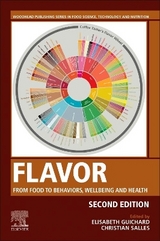
Flavor
Woodhead Publishing Ltd (Verlag)
978-0-08-100295-7 (ISBN)
- Titel erscheint in neuer Auflage
- Artikel merken
The information contained is highly multidisciplinary, starting with chemistry and biochemistry, and then continuing with psychology, neurobiology, and sociology. The book gives coherence between results obtained in these fields to better explain how flavor compounds may modulate food intake and behavior.
When available, physiological mechanisms and mathematical models are explained. Since almost half a billion people suffer from obesity and food related chronic diseases in the world, and since recent research has investigated the possible roles of pleasure linked to the palatability of food and eating pleasure on food intake, food habits, and energy regulation, this book is a timely resource on the topic.
This book links these results in a logical story, starting in the food and the food bolus, and explaining how flavor compounds can reach different receptors, contribute to the emergence of a sensory image, and modulate other systems recognized as controlling food intake and food behavior. The influence of age, physiological disorders, or social environments are included in this approach since these parameters are known to influence the impact of food flavor on human behavior.
Dr. Etiévant is the director of the Nutrition, Chemical, Food Safety and Consumer Behaviour Divisions of The French National Institute for Agronomic Research (INRA) Elisabeth Guichard is recognised as an expert in flavour analysis by the scientific community as demonstrated by her publications in peer review Journals (180) mainly in Food Science, her active participation as oral speaker (130) or by poster presentation (123) in the most famous congresses in the field and her position as associate editor in Flavour and Fragrance Journal. She is editor of 8 books and author of 72 book chapters. She developed innovative methodologies to better understand the interactions between aroma compounds and macromolecules at the molecular level in the aim to predict aroma release from food matrix taking into account their initial composition. Since 2008, E. Guichard focused her research on the dynamic release of aroma compounds during food consumption by human subjects differing in their oral physiology and its impact on dynamic sensory perception. She also studied odor-taste associations to restore taste perception in low salt/sugar/fat products. Christian Salles is research director at INRAE. His main research field carries on in-mouth mechanisms leading to flavour release and perception with in vivo and in vitro approaches. He coordinated the development of chewing simulators dedicated to in vitro approaches of temporal flavour release and food breakdown studies in controlled eating conditions. He has coordinated several projects related to the reduction of salt content in food and in particular a European project (TeRiFiQ – from 1/2012 to 12/2015) on the reduction of salt, fat and sugar in food, with 17 European partners including 11 SMEs. These last years, he focused his research on the temporal release of sodium according to food matrix composition and oral condition. He is the author of 80 publications in peer-reviewed journals, 117 communications in scientific congresses (oral and poster) and the author of 53 book chapters. He is the editor of 2 books. Prof. Voilley is recognized worldwide for her extensive knowledge of mass transfer in small molecules, such as water or aroma, as a function of complex biological matrix structures, and their relationship with hydration level and processing. She has directed more than 50 PhD dissertations. She co-edited “Flavor: From Food to Behaviors, Wellbeing and Health (Elsevier, 2016), and Flavour in Food (Elsevier, 2006). Prof. Voilley is Member of the French Academy of Agriculture.
Part I: Food flavor release in humans 1. Retention and release of taste and aroma compounds from the food matrix during mastication and ingestion 2. Modelling release of taste and aroma compounds from the food matrix and bolus 3. Flavor compounds in biological fluids, in particular amniotic fluid and milk
Part II: Perception of flavor compounds 4. Olfactory perception and integration 5. Taste perception and integration 6. Mouthfeel including fat perception 7. Flavor perception in the gut and other organs 8. Multimodal interactions 9. Central processing of flavor perception 10. Holistic perception and memorization of flavor 11. Prediction of perception using structure-activity models
Part III: Role of flavor perception on food intake 12. Flavor sensitivity (genetic) and food preferences 13. Mechanisms of short and long term regulation of food intake in relation to food flavor 14. Flavor perception and satiation 15. Flavor complexity, familiarity or variety and food intake 16. Early expositions and food preferences / acceptability or neophobia
Part IV: Flavor perception and physiological status 17. Flavor perception and metabolic desease 18. Olfactory disorders and consequences 19. Flavor perception, emotion and wellbeing
Part V: Environmental modulation of perception 20. The learning of human flavor preferences 21. Flavor categorisation and appreciation between socio-cultural groups 22. Sensory and neuro-marketing 23. Influence of price and labelling on flavor appreciation
| Erscheinungsdatum | 03.06.2016 |
|---|---|
| Verlagsort | Cambridge |
| Sprache | englisch |
| Maße | 152 x 229 mm |
| Gewicht | 610 g |
| Themenwelt | Medizin / Pharmazie |
| Technik ► Lebensmitteltechnologie | |
| Technik ► Umwelttechnik / Biotechnologie | |
| ISBN-10 | 0-08-100295-5 / 0081002955 |
| ISBN-13 | 978-0-08-100295-7 / 9780081002957 |
| Zustand | Neuware |
| Haben Sie eine Frage zum Produkt? |
aus dem Bereich



